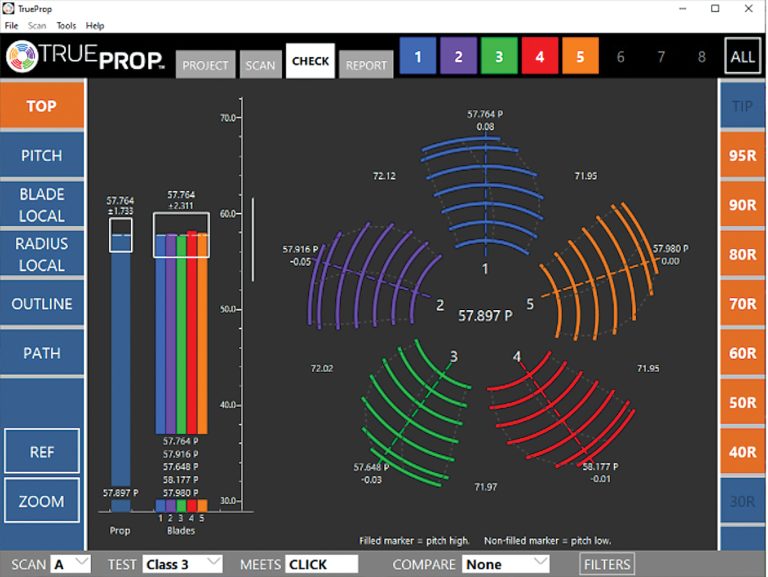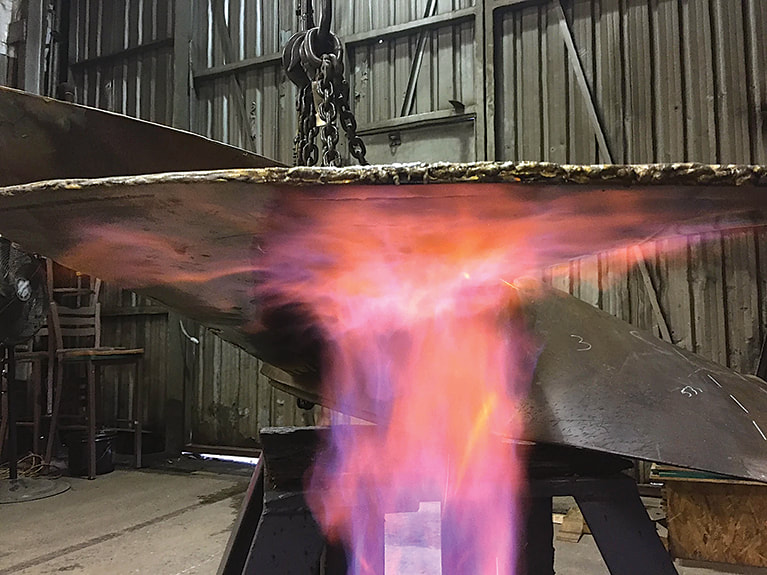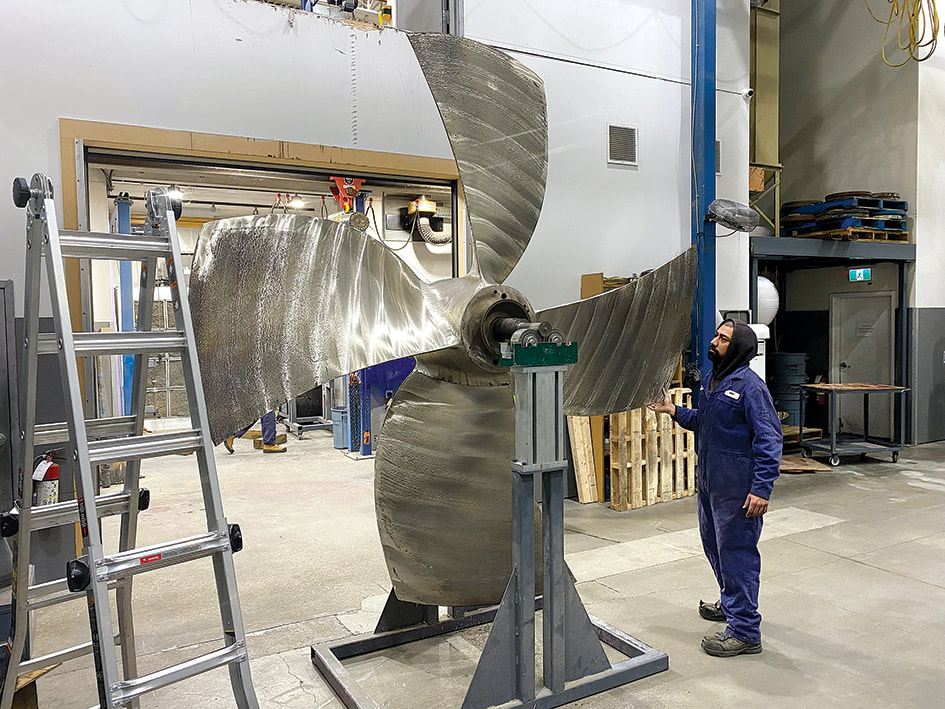*This article was originally published in the July/August 2023 edition of Professional BoatBuilder Magazine, written by Dieter Loibner.
| With all the advances in automation and electrification of boat propulsion systems, propellers remain critical to the task of converting power into propulsion. Made of bronze, nickel, aluminum, stainless steel, or other alloys, they remain mostly out of sight and out of mind as long as they are pushing boats through the water. But that changes when they hit a floating object or accidentally contact the sea floor, which can bend them out of shape or break off part of a blade. Then this underwater end of the drivetrain becomes the focus of anxious attention and the topic of three questions: Repair or replace? How much will it cost? And how long will it take? Many damaged props don’t have to be replaced at great expense if a competent repair shop can make things right. But as propellers become more sophisticated and complex, so does the job of fixing them. Like many other trade jobs, prop repair was once the domain for the skilled use of simple and inexpensive hand tools, a ruler to measure heights, and solid math to make calculations on a piece of paper. Shaping a bent prop involved torches to heat the metal and hammers for truing the blades. “Heat-and-beat,” as this process is still called, took apprentices a long time to learn and many years of experience to master. | TrueProp software connects to specialized propeller measurement machines (digital pitchometers), guiding the operator through scanning and indicating where the propeller needs to be reworked. |
That changed with the advent of personal computers, special software, and electronic measuring devices like wands and scanners that produce and transfer digital data. It’s still a job for skilled technicians, but their tools have evolved.
A screenshot shows the condition of a high-performance seven-blade propeller. The measurements for each blade have a specific color and here are close to each other and within the Class S tolerance.
A high-pitch five-blade prop shows in a similar display.
During the 1990s, several providers of computerized propeller measuring devices entered this limited and specialized market. Only a few survived. “We were asked over and over to develop something for these old machines from the nineties, because the original equipment vendors went out of business,” said Adam Kaplan, CTO of TrueProp in Newmarket, New Hampshire. The firm is a spinoff from HydroComp, Inc., which develops and markets design tools for hydrodynamics and propulsion systems, including software for propeller design, sizing, and manufacturing. “People were using [these machines] but couldn’t get parts or support, [and] were running old Windows 95 computers with all this stuff.” Kaplan said HydroComp initially was contracted for the electronics integration and software development for a new scanning tool, a one-off project that morphed into the TrueProp software, which is part of an integrated solution.
A typical use of TrueProp is tracing the surface of a defective propeller with a scanner to measure blade height and angle. The program provides visual aids in the form of charts and diagrams that illustrate the tolerance (i.e., the acceptable difference between measurements), so technicians recognize what alterations are necessary to bring a damaged prop back into shape.
“Some repairs are outside the limits of what’s possible to do by moving the metal, so sometimes you need to replace things, and, in that case, the software also helps [technicians] measure and determine what they have,” Kaplan said. “There’s another aspect—performance tweaking. If you have an engine problem or speed problem with the boat, [propeller shops] can use TrueProp to make some modifications to the propeller.”
Kaplan observed that propeller designs “are becoming much more advanced and thus much harder to repair with traditional tools.” To keep pace with this evolution and the changing repair and service requirements for newer prop styles, TrueProp partners with Creaform of Lévis, Quebec, Canada, a manufacturer of portable 3D measuring equipment, and Linden Propeller of Dubuque, Iowa, makers of the hydraulic Prop Press and the Digital Data Scanner—all compatible with the TrueProp software.
“We were an early adopter of the software but use it differently than other shops,” said Jody Bell, vice president of sales at Osborne Propellers in Langley, British Columbia, Canada, which serves workboat and leisure craft markets. “We use TrueProp more for the capture of current propeller geometry to feed into our CAD system than for repairs. We design and build propellers for commercial applications, and TrueProp is quite handy in capturing geometry that would otherwise be very hard to measure, specifically rake and skew distribution and chord lengths.” Bell said Osborne runs three different Hale MRI machines for propellers ranging in size from 50“ to 120“ (1.27m to 3.05m) diameter.
Bell commended TrueProp’s ability to customize the software to improve compatibility and workflow when using existing equipment, something he felt had been missing with other vendors in the past. “TrueProp is affiliated with HydroComp, and we use their other software packages, and they talk to one another nicely. We are able to capture design features that allow us to replicate propeller geometry quickly and easily using our existing measuring equipment.” The digital revolution made it a lot cheaper and faster to produce and share data with others in the supply chain. Osborne also relies on HydroComp’s PropCAD to produce drawings and coordinate tables for manufacturing custom propellers, and for its built-in features to calculate thicknesses and provide torsional data to engine and gear suppliers.
Asked about sending workers to shipyards to inspect and repair propellers, Bell said he prefers to work in-house, where his technicians can get better results faster than off-site. “The cost of insurance is also a factor. Adding ship repairers’ liability insurance is a huge expense, so we choose not to. I’m certain that this costs us some jobs every year, but we’re better off in the long run.” Osborne does not cast propellers and often chooses between machining in-house or through subcontractors as needed. Contracting out certain types of work, Bell explained, “allows us to scale up our capabilities without the capital expense.”
In some cases, heat is still applied to shape damaged propellers.
For nearly 30 years, Cool Breeze Marine of Osage Beach, Missouri, has been fixing props on the shores of the Lake of the Ozarks. Customers include local boaters with prop trouble, but the shop also works on specimens sent from other parts of the country, not just by recreational boaters but also by racers. “Manual pitch blocks, rake gauges, a good eye, and 30 years of knowledge” is what shop owner George Peter used before switching to the TrueProp software and PropExpert, a program to calculate diameter, pitch, reduction-gear ratio, and blade area when sizing propellers.
Peter’s shop, which is certified by the National Marine Propeller Association sees a diverse range of defective propellers, from trolling motors to trawlers, and from aluminum runabout props to 6-blade high-performance stainless-steel to 8-blade 40“-diameter (1m) inboard yacht propellers. “People hit rocks, logs, their own boat trailers, or dock lifts and cables,” he said. “In the rainy season, it’s mostly logs. In the dry season, it’s mostly rocks. Damage happens all year long.” Peter calls TrueProp “the most accurate system on the market today” because it eliminates guesswork. He uses a Linden Digital Data Scanner with the TrueProp software to analyze the propellers and Linden’s hydraulic Prop Press 360 to bend them back into shape.
Not every customer checks in with prop trauma. Many ask for a propeller tune-up to improve performance. “Where the Prop Press 360 and TrueProp software really come into play is when we are doing performance modifications,” Peter said. “We can take existing specs and data off the prop, talk with the customer to see what they want their boat to do or any performance issues they’ve encountered, and we figure out what it’s going to take to change the props to make that happen. Bending the prop accordingly can save customers time and thousands of dollars, and it gives them better fuel economy and longer engine life, because the prop will be modified to help the boat perform the way it should.”
Peter’s shop, which is certified by the National Marine Propeller Association sees a diverse range of defective propellers, from trolling motors to trawlers, and from aluminum runabout props to 6-blade high-performance stainless-steel to 8-blade 40“-diameter (1m) inboard yacht propellers. “People hit rocks, logs, their own boat trailers, or dock lifts and cables,” he said. “In the rainy season, it’s mostly logs. In the dry season, it’s mostly rocks. Damage happens all year long.” Peter calls TrueProp “the most accurate system on the market today” because it eliminates guesswork. He uses a Linden Digital Data Scanner with the TrueProp software to analyze the propellers and Linden’s hydraulic Prop Press 360 to bend them back into shape.
Not every customer checks in with prop trauma. Many ask for a propeller tune-up to improve performance. “Where the Prop Press 360 and TrueProp software really come into play is when we are doing performance modifications,” Peter said. “We can take existing specs and data off the prop, talk with the customer to see what they want their boat to do or any performance issues they’ve encountered, and we figure out what it’s going to take to change the props to make that happen. Bending the prop accordingly can save customers time and thousands of dollars, and it gives them better fuel economy and longer engine life, because the prop will be modified to help the boat perform the way it should.”
A technician at Osborne Propellers in Langley, British Columbia, Canada, balances a large four-blade prop.
When it comes to bent props, there are different levels of mystery, Peter intimated. If the extent of the damage is visible, the evaluation by experienced technicians is usually quick and straightforward. When a customer tells him, “We didn’t hit anything, but now the boat shakes,” the only way to see it is with a scan that shows where the bend is and where to fix it. Smaller props are put on pitch blocks and beat into shape with rawhide-faced hammers, while large propellers are put on the Prop Press to be scanned and subsequently bent back with hydraulic force until they conform to specifications. If necessary, missing metal is welded back on, followed by grinding, finishing, and balancing. “Turnaround time depends on the level of damage and the time of year the prop comes into our shop,” Peter said. “It can take anywhere from one to two days to three weeks, [but] average is about two weeks.”
As a complication, propellers continue to evolve. “Back in the day, we talked about pitch, like a propeller can be a 20“ [0.5m] pitch,” Kaplan mused. “And traditionally those 20“ props measured that same value everywhere across the prop. But designs have advanced so much now [with] a lot more curvature and variation from the leading to the trailing edge of the blade, and from the root of the blade up to the tip. So you really need a digital system that allows you to compare these blades in a meaningful way. Traditional tools don’t quite work with these newer propeller designs. People can’t just repair them like they used to. They can’t use their grandfather’s methods.”
More examples of propeller repairs can be found on TrueProp’s showcase page
TrueProp, 5 Penstock Way, Suite 101, Newmarket, NH 03857, USA, tel. 603–868–3366.
As a complication, propellers continue to evolve. “Back in the day, we talked about pitch, like a propeller can be a 20“ [0.5m] pitch,” Kaplan mused. “And traditionally those 20“ props measured that same value everywhere across the prop. But designs have advanced so much now [with] a lot more curvature and variation from the leading to the trailing edge of the blade, and from the root of the blade up to the tip. So you really need a digital system that allows you to compare these blades in a meaningful way. Traditional tools don’t quite work with these newer propeller designs. People can’t just repair them like they used to. They can’t use their grandfather’s methods.”
More examples of propeller repairs can be found on TrueProp’s showcase page
TrueProp, 5 Penstock Way, Suite 101, Newmarket, NH 03857, USA, tel. 603–868–3366.






